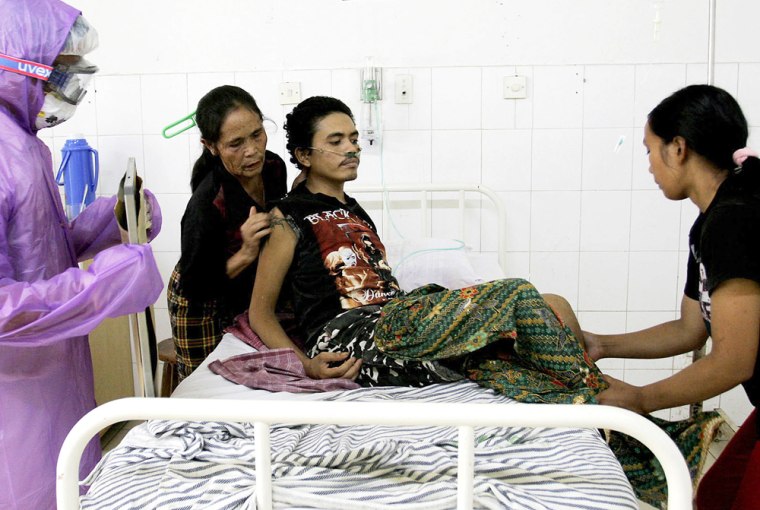The sole survivor in a cluster of Indonesian relatives infected with bird flu lies in an open-air hospital room, chickens pecking outside his door and visitors shuffling in and out without masks or protective gear.
The patient, Johannes Ginting, is still very weak but seems unconcerned. He even fled the hospital when he first fell ill with the H5N1 virus, and has since resisted treatment, balking at the bird flu drug Tamiflu and other medicine.
"We had actually given masks and gloves to the family, and we informed them how dangerous this disease is, but they didn't cooperate with us," said Nurrasyid Lubis, deputy director of Adam Malik Hospital. "We also informed him how dangerous it is, but he didn't believe us."
On the other side of the hospital, health workers got a briefing on the importance of infection control. Posters depicting chickens and a burning globe are on walls throughout the building warning of bird flu, which has killed at least 124 people worldwide since it began ravaging Asian poultry in late 2003.
A quarter of the human deaths have been Indonesia, which has been criticized for acting too slowly to stop the spread of the disease.
Lack of public awareness is part of the problem, health experts say, noting that many people in the sprawling countryside have never heard of bird flu. Others, like 25-year-old Ginting, deny it is a problem.
Largest cluster ever reported
At least six of Ginting's relatives from tiny Kubu Simbelang village in North Sumatra have died of the virus. A seventh was buried before samples could be taken, but the World Health Organization considers her part of the cluster — the largest ever reported.
The case has drawn much attention because the infections have not been linked to contact with birds. Experts suspect limited human-to-human transmission may have occurred, but say no one else outside the family has fallen ill.
The disease remains hard for people to catch and most human cases so far have been traced to contact with infected birds. But experts fear the virus will mutate into a highly contagious form that passes easily among people, possible sparking a pandemic. They stress, however, that has not happened in Kubu Simbelang.
Ginting's mother, who declines to reveal her name, sits on a straw mat on a grassy patch outside her son's hospital room, at the end of a row of ground-floor rooms that open to the outside.
Despite losing three children and four grandchildren, she is not afraid to care for her son, who must be fed and is too weak to sit unaided since falling ill May 4.
She said he is slowly recovering, but still suffers a cough and struggles to speak.
"I'm not afraid. I don't even wear a mask or anything," she said. "If it spreads, I will be the first one to die."
Ginting's mother chewed on betel nut, a mild natural stimulant, as hens, roosters and chicks scratched the ground just feet away. Several cats also roamed outside her son's door.
"Why would I have to be afraid of chickens around here," she said. "The ones who died, they didn't eat chicken, after all."
The family, which has spoken to few outsiders, has been the subject of intense international interest because of the number of its members who were infected. WHO officials say it marks an important development with the H5N1 virus, which is thought to have been transmitted among people in a handful of other cases.
So far, scientists think, all such case have involved passing the virus between blood relatives. Some experts theorize that may mean some people have a genetic susceptibility to the disease, but there is no evidence to support that.
Neighbors doubt authorities
Many people in Ginting's farming village do not believe bird flu caused the deaths because no spouses or neighbors also got sick. Many, including Ginting and his family, have been uncooperative with health authorities.
"Johannes doesn't want to be injected, doesn't want to take Tamiflu or other antibiotics," Lubis said, although he added that the patient ha become more agreeable since first being hospitalized.
There is also a lack of knowledge about preventative steps, as shown by Ginting's uncovered visitors.
Lubis said the hospital held a seminar for the staff Monday to discuss infection control measures.
As he spoke, a woman outside Ginting's room picked through his garbage without gloves or other germ-protective gear. Family members of patients in the adjoining room lounged on the floor near his open door.
WHO guidelines call for health workers to wear masks, gloves, gowns, goggles and special boots when coming into contact with a bird flu patient, WHO spokesman Dick Thompson said.
Nurses and doctors who entered Ginting's room did wear protective gear, but no one interfered with the unprotected visitors.
Lubis said the hospital has done the best it can to isolate Ginting.
"For the room, we've done the maximum effort we can do," he said. "We don't know what more we can do beyond that."
